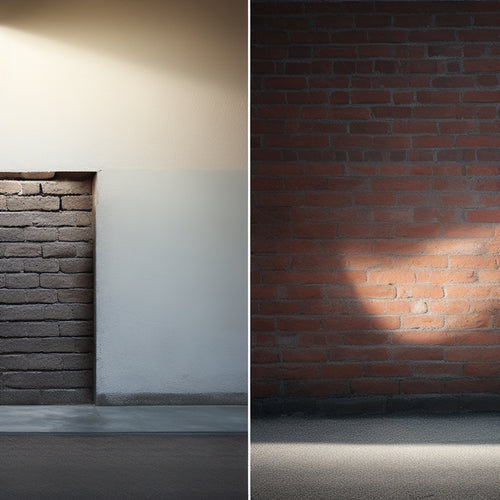
What Safety Gear Do Home Renovators Need
Share
As you tackle your home renovation project, you'll need to prioritize your safety above all else. You'll require essential personal protective equipment like gloves, hearing protection, and a dust mask or respirator to safeguard against cuts, loud noises, and airborne contaminants. Additionally, fall protection gear like safety glasses, steel-toed boots, and scaffolding harnesses will prevent accidents when working at heights. Specialized tools, such as demolition gloves and insulated hand tools, will also be necessary for specific tasks. By investing in this safety gear, you'll be well-equipped to handle the unique hazards of your renovation project, and doing so will pave the way for a successful and injury-free outcome.
Key Takeaways
• Home renovators need gloves with grip patterns to prevent tool slippage and hand injuries from cuts, abrasions, and punctures.
• Hearing protection like earplugs or earmuffs is essential to reduce noise levels by 15-30 decibels and prevent hearing damage.
• A dust mask or respirator is necessary to avoid inhaling silica dust and other airborne contaminants during concrete and demolition work.
• Safety glasses or goggles protect eyes from flying debris, chemical splashes, and other hazards, while steel-toed boots prevent foot injuries.
• Specialized safety tools like insulated hand tools, mechanical aids, and noise reduction tools are required for specific tasks like electrical work and heavy lifting.
Essential Personal Protective Equipment
When tackling a home renovation project, you wear essential personal protective equipment (PPE) to shield yourself from the hazards of sawdust, debris, and toxic substances.
Gloves are a vital component of your PPE arsenal, as they protect your hands from cuts, abrasions, and punctures. Choose gloves made from durable materials that can withstand the rigors of construction, such as heavy-duty cotton, synthetic fibers, or a combination of both. Additionally, consider gloves with grip patterns on the palms to prevent slipping and dropping tools or materials.
Another significant aspect of PPE is hearing protection. Prolonged exposure to loud power tools and machinery can lead to permanent hearing damage. Invest in earplugs or earmuffs that can reduce noise levels by 15-30 decibels. These devices can be disposable or reusable, depending on your preference.
Concrete Safety Gear Checklist
You'll need a thorough concrete safety gear checklist to tackle concrete-related tasks, such as drilling, grinding, or chiseling, which can expose you to hazardous silica dust, flying debris, and other risks. When working with concrete, it's essential to prioritize your safety above all else.
Start by wearing a dust mask or respirator to prevent inhaling silica dust, which can cause serious respiratory problems. Safety glasses or goggles will protect your eyes from flying debris, while a face shield will provide additional protection.
For concrete mixing, confirm you wear heavy-duty gloves to prevent skin irritation and abrasion. A long-sleeved shirt and pants will also protect your skin from concrete splashes.
When performing surface treatment tasks, such as grinding or sanding, wear a dust-resistant coverall to prevent dust from penetrating your clothing. Don't forget to wear steel-toed boots with slip-resistant soles to prevent slips and falls.
Fall Protection and Prevention
Fall protection gear is crucial for home renovators working at heights, as a single misstep can result in devastating injuries or fatalities. This makes it essential to implement a thorough fall protection strategy.
You'll need to assess the job site to identify potential fall hazards, such as open edges, holes, and uneven surfaces.
Verify you're using ladders safely by maintaining three points of contact, facing the ladder when climbing up or down, and never overreaching or leaning over the side rails.
When working on scaffolds, follow scaffold guidelines, including verifying that the structure is sturdy, level, and securely anchored to the building. You should also wear a harness and be tied off to a secure anchor point.
Regularly inspect your fall protection gear, such as harnesses and lanyards, to confirm they're in good condition and functioning properly.
Don't take shortcuts – falling from heights can be deadly, and it's your responsibility to protect yourself and your team.
Respiratory and Eye Protection
Protect your respiratory system from airborne contaminants and hazardous materials by wearing approved respirators, which should be selected based on the specific job requirements and potential hazards identified during the risk assessment.
This is vital, as respiratory hazards can lead to serious health problems, including lung disease and even cancer. When choosing a respirator, consider the type of airborne contaminants you'll be exposed to, such as dust, chemicals, or biological agents.
Make certain the respirator fits properly and is worn correctly to guarantee maximum protection.
In addition to respiratory protection, don't forget about eye safety. Safety glasses or goggles can protect your eyes from flying debris, chemicals, and other hazards.
When selecting eye protection, consider the type of hazard you'll be exposed to and choose accordingly. For example, if you'll be working with chemicals, choose goggles with a seal around the eyes to prevent splashes.
Remember, eye injuries can be devastating, so take the necessary precautions to protect your vision.
Specialized Safety Tools Required
When tackling specific tasks like demolition, electrical work, or heavy lifting, it's vital to have specialized safety tools at your disposal to prevent accidents and injuries. These tasks often require unique protection that goes beyond the standard respiratory and eye protection.
For instance, demolition work demands specialized gloves that can withstand the rigors of heavy-duty demolition, providing protection from cuts, abrasions, and impact. Similarly, electrical work necessitates the use of insulated hand tools and gloves to prevent electrical shock.
Heavy lifting, on the other hand, requires the use of mechanical aids like pulleys, winches, or dollies to reduce the physical strain on your body. Additionally, noise reduction tools like earplugs or earmuffs are essential when operating loud machinery to prevent permanent hearing damage.
Frequently Asked Questions
Can I Reuse Safety Gear After It's Been Damaged or Worn Out?
When it comes to your safety gear, you can't afford to take risks. If it's been damaged or worn out, you shouldn't reuse it.
Instead, you need to prioritize safety gear maintenance and inspect your equipment regularly.
When you find damaged gear, you must dispose of it properly through damaged gear disposal processes.
How Often Should I Inspect My Safety Equipment for Damage?
As you suit up for another day of renovation, remember that your safety gear is only as reliable as its last inspection.
Don't let complacency become a ticking time bomb - regular checks are essential.
You should inspect your safety equipment daily, before each use, and thoroughly every 3-6 months.
This inspection frequency guarantees safety gear maintenance is on point, and you can tackle that demo job with confidence.
Are Safety Gear Requirements the Same for DIY and Professional Renovators?
When you're tackling a renovation, whether as a DIY enthusiast or a professional contractor, you might assume safety gear requirements are the same across the board.
However, that's not entirely true.
While DIY risks are often underestimated, professional standards dictate a higher level of protection.
You'll need to adhere to stricter guidelines, such as wearing respiratory protection and steel-toed boots, to guarantee a safe working environment that meets industry standards.
Can I Substitute Safety Gear With Makeshift or Homemade Alternatives?
You're tempted to think you can MacGyver your way to safety, but don't even consider substituting makeshift materials or homemade solutions for proper safety gear.
It's a recipe for disaster. You're not saving time or money; you're risking your life.
Those DIY YouTube tutorials might make it look easy, but they're not a substitute for rigorously tested and certified safety equipment.
Don't gamble with your well-being – invest in the real deal.
Are There Any Safety Gear Recommendations for Specific Renovation Tasks?
When tackling a renovation project, you'll want to identify the specific task gear required to mitigate risks.
For example, when working with power tools, you'll need protective eyewear and ear protection.
For demolition, wear a dust mask and heavy-duty gloves.
Don't underestimate the renovation project risks - take the time to research and invest in the right gear for each task to guarantee your safety.
Conclusion
As you suit up for your home renovation project, remember that safety gear is your armor against the unknown.
A single misstep can be devastating, but with the right protection, you'll be invincible.
Don't let your renovation dreams turn into a nightmare - wear your helmet, gloves, and goggles like a badge of honor.
They're your shield against the harsh realities of construction.
With these essentials, you'll be ready to tackle any challenge that comes your way, and emerge victorious on the other side.
Related Posts
-

Why Use Concrete Blocks in Home Renovation
You're considering using concrete blocks in your home renovation, and for good reason: they offer a unique combinatio...
-

5 Vital Safety Tips for DIY Renovation Success
When tackling a DIY renovation, you'll need to prioritize safety above all else. Start by protecting yourself from fl...
-

3 Best Planter Shopping Timeline Tips for Renovators
When incorporating planters into your renovation project, you'll want to plan carefully to avoid delays and guarantee...


